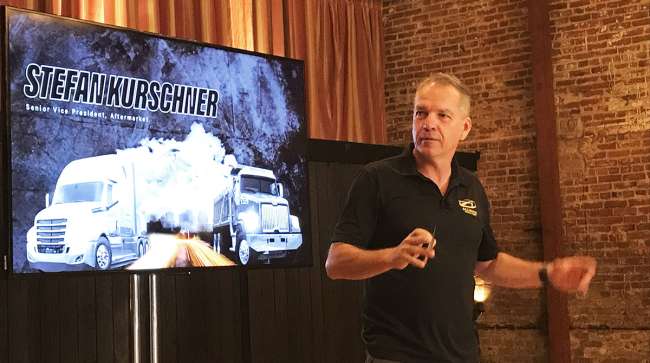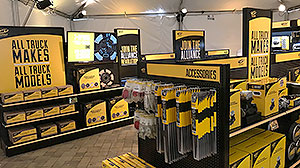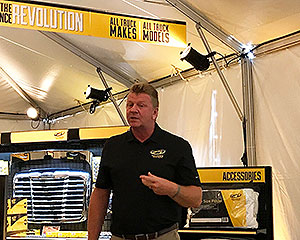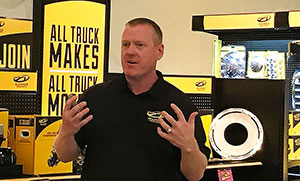DTNA Targets 24-Hour Dealer Repair Turnarounds

YOUNTVILLE, Calif. — Daimler Trucks North America is targeting 24-hour turnaround times for truck repairs at its dealerships and is expanding its aftermarket component business as it moves to boost its parts and repair business, company executives said.
“It’s not the event of the breakdown that makes the difference — it’s the way you get it back on the road,” Stefan Kurschner, senior vice president of aftermarket for DTNA, said during a media event here held to spotlight the company’s Alliance Truck Parts brand and other service-related initiatives. Included is a goal the company is setting for its service facilities: turnaround times of 24 hours or less for repairs. “That is what we’re going to promise our customers,” he said. “In 24 hours, your truck is back on the road.”
It’s a goal Kurschner said is attainable, noting that 58% of DTNA dealers nationwide are hitting the mark, including some that have 80% turnaround rates.

This display represents how the inside of a typical Alliance store might be laid out. (Joe Howard/Transport Topics)
Kurschner told Transport Topics that DTNA introduced the concept to dealers during a meeting in May. He noted that while some dealers may have expressed reluctance to the plan, there was broad agreement that customer needs demand it. “They see the need in the marketplace,” he said. “There is no disagreement that we need to get faster.”
He said that the company will measure its performance to ensure it’s meeting the commitment and will be up front with customers should the repair exceed the 24-hour window. “We are going to check ourselves to make sure that we fulfilled that” commitment, he said.
He added that what types of repairs are covered — and which are not — will be made clear to customers.
“We are setting everything in place. There will be service events — if you have a big accident we will not rebuild your truck in 24 hours — but there will a clear, defined expectation,” he said. “It’s not engine rebuilds or collision repair, but if you have a regular service event, we are going to make it happen. And if we cannot fulfill the 24 hours, we are going to tell you why. And it’s not because we’re missing a part. That’s on us.”
To that end, the Alliance aftermarket division is planning to open a parts distribution center in Phoenix in the first quarter of next year and intends to add centers should the need arise. The current network of centers could be expanded, Kurschner told TT.
Alliance also is expanding its product line to be more responsive to customers looking for what company executives defined as “value” parts — those that are designed for quality but which have an expected life span shorter than a factory part.

Finn said buyers in the value parts segment still care about quality. (Joe Howard/ Transport Topics)
“Some customers are actually interested in just keeping the vehicle going,” said John Finn, DTNA’s director of aftermarket network parts sales for the eastern United States and Canada. “They have very specific needs for their level of quality. They want quality, but they don’t necessarily need something to last for 10 years. Maybe they need it to last for five years.”
The key, noted Brad Williamson, DTNA’s manager for Alliance parts and remanufacturing marketing, is positioning in the marketplace. “You have to be where the customer feels good about the value they are getting,” he said.
The value segment is one Alliance is targeting more aggressively, Finn said, as it aims to establish a leadership position in the $30 billion aftermarket parts industry. “We see an opportunity to go after the entire parts business,” he said.
A key part of that strategy is building out the Alliance distribution network — specifically, stand-alone stores. DTNA’s strategy is to identify regions where there is demand and help dealers launch stores. The stores can be stand-alone or built into dedicated space at a dealership, Finn said. Williamson noted that three such stores have been launched, and plans for 12 more are underway.
Williamson added that DTNA is working with a consultant to infuse the stores with a retail aesthetic. “In the past, we had parts people helping design a retail experience,” he said. “Well, I’m not an expert retailer, [so] we went out and we partnered with a firm that is expert in retail.”

Williamson said DTNA is working with a retail consultant on the design of Alliance parts stores. (Joe Howard/Transport Topics)
He also noted that Alliance will expand its lineup of 52 product lines to more than 80 over the next 18 to 24 months. “We have tons of plans,” he said.
That said, he noted that dealers are free to offer any parts — including from other manufacturers — in these stores, as they would know best what their customers will demand.
“From the customer’s perspective, if you don’t have it at the dealership or at the parts store when I show up, you don’t have it in stock,” he said.




